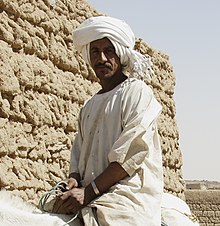عرب سودانيون | |
|---|---|
 Sudanese Arab from the tribe of Manasir | |
| Total population | |
| c. 40,000,000+ | |
| Regions with significant populations | |
30,000,000[1] | |
| 4,635,000[2] | |
| 440,000[2] | |
| 348,000[2] | |
| 230,000[2] | |
| 179,000[2] | |
| 75,000[2] | |
| 60,000[2] | |
| 19,000[2] | |
| 9,600[2] | |
| Languages | |
| Sudanese Arabic | |
| Religion | |
| Sunni Islam | |
| Related ethnic groups | |
| Arabs, Nubians,[3] Beja, Cushites, Nilo-Saharans | |
Sudanese Arabs (Arabic: عرب سودانيون, romanized: ʿarab sūdāniyyūn) are the inhabitants of Sudan who identify as Arabs and speak Arabic as their mother tongue.[4] Some of them are descendants of Arabs who migrated to Sudan from the Arabian Peninsula,[5] although the rest have been described as Arabized indigenous peoples of Sudan of mostly Nubian,[6] Nilo-Saharan, and Cushitic[7] ancestry who are culturally and linguistically Arab, with varying cases of admixture from Peninsular Arabs.[8] This admixture is thought to derive mostly from the migration of Peninsular Arab tribes in the 12th century, who intermarried with the Nubians and other indigenous populations, as well as introducing Islam.[9][10] The Sudanese Arabs were described as a "hybrid of Arab and indigenous blood",[11] and the Arabic they spoke was reported as "a pure but archaic Arabic".[12] Burckhardt noted that the Ja'alin of the Eastern Desert are exactly like the Bedouin of Eastern Arabia.[13]
Sudanese Arabs make up 70% of the population of Sudan,[14] however prior to the independence of South Sudan in 2011, Sudanese Arabs made up only 40% of the population.[15] They are Sunni Muslims and speak Sudanese Arabic. The great majority of the Sudanese Arabs tribes are part of larger tribal confederations: the Ja'alin, who primarily live along the Nile river basin between Khartoum and Abu Hamad; the Shaigiya, who live along the Nile between Korti and Jabal al-Dajer, and parts of the Bayuda Desert; the Juhaynah, who live east and west of the Nile, and include the Rufaa people, the Shukria clan and the Kababish; the Banu Fazara or Fezara people who live in Northern Kordofan; the Kawahla, who inhabit eastern Sudan, Northern Kordofan, and White Nile State; and the Baggara, who inhabit South Kordofan and extend to Lake Chad. There are numerous smaller tribal units that do not conform to the above groups, such as the Messelemiya, the Rikabia, the Hawawir people, the Magharba, the Awadia and Fadnia tribes, the Kerriat, the Kenana people, the Kerrarish, the Hamran, amongst others.[16]
Sudan also houses non-Sudanese Arab populations such as the Rashaida that only recently settled in Sudan in 1846, after migrating from the Hejaz region of the Arabian Peninsula.[17] Additionally, other smaller Sudanese groups who have also been Arabized, or partially Arabized, but retain a separate, non-Arab identity, include the Nubians, Copts, and Beja.
- ^ "The Arab-Sudanese people group is reported in 18 countries". Retrieved 9 January 2019.
- ^ a b c d e f g h i "The Arab-- Sudanese people group is reported in 18 countries". The Joshua Project. Retrieved 9 January 2019.
- ^ Hale, Sondra (1973). Nubians: A Study in Ethnic Identity. Institute of African and Asian Studies, University of Khartoum. p. 24. Retrieved 14 November 2017.
- ^ Ibbotson, Sophie; Lovell-Hoare, Max (26 November 2012). Sudan. Bradt Travel Guides. p. 28. ISBN 978-1-84162-413-6.
- ^ Levy, Patricia; Latif, Zawiah Abdul; Young-Brown, Fiona (15 April 2017). Sudan. Cavendish Square Publishing, LLC. p. 64. ISBN 978-1-5026-2602-8.
- ^ Richard A. Lobban Jr. (2004): "Historical Dictionary of Ancient and Medieval Nubia". The Scarecrow Press. P. 37
- ^ Jakobsson, Mattias; Hassan, Hisham Y.; Babiker, Hiba; Günther, Torsten; Schlebusch, Carina M.; Hollfelder, Nina (24 August 2017). "Northeast African genomic variation shaped by the continuity of indigenous groups and Eurasian migrations". PLOS Genetics. 13(8): e1006976. doi:10.1371/journal.pgen.1006976. ISSN 1553-7404. PMC 5587336. PMID 28837655.
- ^ "المشاهير | الصفحة الرئيسية". almshaheer.com. Retrieved 12 October 2014.
- ^ Inc, IBP (15 June 2017). Sudan (Republic of Sudan) Country Study Guide Volume 1 Strategic Information and Developments. Lulu.com. p. 33. ISBN 978-1-4387-8540-0.
{{cite book}}:|last=has generic name (help) - ^ Royal Anthropological Institute of Great Britain and Ireland, JSTOR (Organization) (1888). Journal of the Royal Anthropological Institute of Great Britain and Ireland, Volume 17. The Institute. p. 16. Retrieved 8 May 2011.
jaalin.
- ^ Kadoda, Gada (28 March 2022). Sudanese Intellectuals in the Global Milieu: Capturing Cultural Capital. Rowman & Littlefield. p. 117. ISBN 978-1-7936-2277-8.
- ^ Cite error: The named reference
:4was invoked but never defined (see the help page). - ^ This article incorporates text from a publication now in the public domain: Chisholm, Hugh, ed. (1911). "Jā'alin". Encyclopædia Britannica. Vol. 15 (11th ed.). Cambridge University Press. p. 103. Citation: The Anglo-Egyptian Sudan, edited by Count Gleichen (London, 1905)
- ^ "Sudan", The World Factbook, Central Intelligence Agency, 31 August 2022, retrieved 4 September 2022
- ^ Adebanwi, Wale; Orock, Rogers (24 May 2021). Elites and the Politics of Accountability in Africa. University of Michigan Press. p. 368. ISBN 978-0-472-05481-7.
- ^ MacMichael, Harold (1922). A History of the Arabs in the Sudan And Some Account of the People who Preceded them and of the Tribes Inhabiting Dárfūr. Cambridge University Press. ISBN 9780511696947.
- ^ Rashaida People History, Niaz Murtaza The pillage of sustainability in Eritrea 1998, p.177